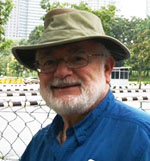By Oliver B. Pollak

‘Fellow Travelers’ used to have an awkward anti-communist McCarthyean ring; no longer. Now FT’s are strangers you meet on tours, who travel and dine with you; companions of convenience, from which camaraderie may develop.
The New York Times supplements newspaper revenues by sponsoring tours accompanied by reporters to familiar, remote and exotic destinations. Mainland and island Southeast Asia contain 640,000,000 people, slightly less than a tenth of the world’s inhabitants, with probably the lowest percentage of Jews anywhere in the world, except among Israel’s Middle East enemies.
My wife, Karen and I visited Saigon and Hanoi, Vietnam, Siem Reap, Cambodia, Singapore, Malaysia, Thailand, and Burma. We benefited from twelve lectures by New York Times reporters Roger Cohen from New York, Richard Paddock from Bangkok, Mike Ives from Hong Kong, and Ian Fisher from Rome. Economics reporter Gretchen Morgenson cancelled her appearance and went to the Wall Street Journal.
The travelers left the United States and arrived in Ho Chi Minh City via Tokyo, Seoul and Dubai.
Our six country itinerary, 1,900 miles from Vietnam to Burma, had a population of 270 million Buddhists, Muslims, Hindus and Christians, and less than 3,000 Jews. There were more Jews in colonial days, many from Baghdad. The Japanese invasion and the creation of the state of Israel prompted Jews to move. Israel has embassies in Vietnam, Singapore, Thailand, Burma, and the Philippines, but not in Muslim majority countries, Malaysia and Indonesia.
Identifying Jewish presence by looking for Stars of David was purposeless. Swastikas adorning centuries old architecture, though off putting, had no anti-Jewish context. Google revealed 300 Jews in Vietnam with Chabad in Saigon and in Hanoi. Cambodia has a Chabad in Phnom Penh. Singapore has 2,000 Jews, two synagogues and Chabad. Sheldon Adelson has an interest in the city’s signature Marina Bay Sands hotel. Malaysia, with no Jews to speak of, is reputedly anti-Semitic though during my three day visit I saw no evidence of it, nor did I search it out. Thailand has a few thousand Jews and Chabad in Bangkok. Burma’s miniscule Jewish population maintains a historic synagogue in Yangon. Indonesia’s 200 Jews, and Chabad in Laos and the Philippines, were beyond the scope of our travels.
A visit to one of Melaka’s 29 museums, the Malacca Heritage Center, where 86-year-old Melbourne trained architect Charles K. Chia maintains a 1906 building, his family home, and over a century of accumulating, revealed a safe made in Vienna, Austria, marketed by Katz Brothers out of Singapore & Penang, a valuable example connecting the dots of Jewish presence.
Roger Cohen, with a Lithuanian heritage, South African birth, Oxford education, naturalized American, 30 year NYT veteran spoke intimately about his 2015 memoir, The Girl from Human Street, A Jewish Family Odyssey, also subtitled Ghosts of Memory in a Jewish Family. He contrasted Bosnia and Sarajevo fetishizing grievances to Vietnam which placed the future above vengeance. The heritage of the “American War” did not deter Vietnam from developing a prosperous capitalist economy and communist political system. Seventy percent of Vietnam’s population was born after 1975, when the war came to an end. Cohen closed his talk with Yehudi Amichai’s poem, “The Tourist.”
Our fellow travelers were retired professionals, physicians, educators, lawyers, bankers, psychologists, and writers. The 32 travelers came from 15 states. Only two smoked. They found out about the tour by reading the bucket list generator New York Times Sunday Travel Section. The no single supplement attracted some.
The introspective Jewish lens identified 17 Jews among 26 travelers, four journalists, and two staffers, 32 people. They were Jewish or strongly identified with Judaism by marriage or partnership. Determining who is a Jew runs from observation and listening, to unasked questions: cues include last and first name, residence, occupation, travel connections, marital status, children and grandchildren, and age. Faith is wormed out by hints, suggestions, name dropping, innuendo, the occasional utterance of cues, oy vey, chutzpah, spiel, shmooze, mensch, schvitz, and schlep. Its pretty clear when you overhear a conversation about a grandson’s bar mitzvah. The number of Jews could have been higher than 53%. Was Ash formerly Ashkenazi, or Cole, Cohen?
The seventeen Jews, twelve families in synagogue nomenclature, hailed from five states; New York 7; California 5; and Connecticut 2, and Texas and Missouri one each. Eleven were women. Four were naturalized Americans. These talkative, interesting people with a lust for travel and new experiences, ranged from 60 to 89. Twelve days later the ship docked at Yangon; the tour over, our fellow travelers went off in different directions, leaving their emails behind.
*
Pollak is a freelance writer.